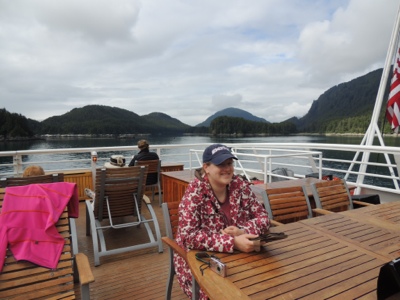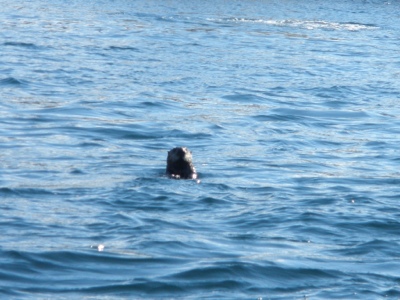Weather: Mid 50s and absolutely beautiful, sunny with nary a cloud in the sky
Steps: Shaun - ?? steps, ?? floors climbed (we don't have cell signal, so she couldn't see how many steps she walked); Shannon - 6,344 steps, 7 floors climbed
Critter count: Lots of different kinds of sea birds, including cormorants, a bunch of different kinds of gull, a lot of bald eagles, a Great Blue Heron, 2 sandpipers, and marbled merrelets (M&Ms), several otters (including a momma and baby), tons of sea lions (literally), at least two humpback whales, a momma and baby bear, a ground squirrel, and jellyfish as far as the eye can see
We wondered if anything could possibly beat yesterday, but somehow, today at least equaled it in awesomeness. It started innocently enough, with an early wake-up call from Cindy telling us that there was a momma and baby bear on the beach. We watched them for awhile until they left the beach, but then we prepared for excursions to an area near that very beach!
Mom and I decided to go on different excursions in Port Althorpe this morning because I wanted to do a "bushwhacking" exploratory hike, which didn't appeal to Mom at all, so she went on a tour by zodiac around the inlet. Neither one of us was hugely satisfied with our experience.
The exploratory hike was so named because there are no maintained trails in the area, so we were going to be blazing our own trail and bushwhacking our way through...or so we thought. Alas, we spent most of our time in the intertidal zone, which was visible because the tide was out. It was covered in seaweed, barnacles, mussels, algae, and all sorts of interesting smelling things.
We did trek through a small bit of forest, so I got some pictures of interesting fungi and whatnot, but we only went a short ways in to get to a stream that had spawning pink salmon in it. Of course, the banks were lined with dead salmon in various states of decay, which meant that it smelled a bit gnarly and had little bugs all over the place that bit me right on the forehead!
The stream was clear, though, so we were able to see the salmon making their way up to their spawning grounds. There was some biting and agitation, which we could totally understand given that they were desperately trying to spawn before they used up the last of their strength and died. They don't eat the whole time they are in the freshwater streams, and they are already old by this time, so once they spawn, if they are able to and don't get eaten beforehand, they die within a few hours. That's why the stream banks were lined with dead salmon bodies. Once they die, their bodies provide nourishment for the area plants and wildlife, including their own offspring once they're born. They definitely epitomize the circle of life.
We had to keep our eyes out for bears the whole time we were on shore because we already knew they were around, and they are trying to eat lots of salmon to add fat before they go into hibernation. As a biological sidebar, the naturalists told us that bears, like sea lions, do what is called "delayed implantation" which means that the fertilized egg does not attach to the uterine wall right after mating but instead waits until after the bear is in hibernation and then only if she has put on enough fat stores to support the baby. Mother Nature is amazing, isn't she?
Back to our regularly scheduled programming: The stream we were viewing had tons of signs of bears, including flattened grass, paw prints, and scat (which made watching where we were walking a necessity). We didn't actually see any bears while we were on shore, but we did see a ground squirrel, some eagles, lots of gulls, and, the piece de resistance, a Great Blue Heron. The heron was young, so it didn't have the distinctive plumage, but it very nicely posed for us, so I got some really great shots for Mom.
While I was on shore, Mom was out in the zodiac getting a view of the area from the water. Here is her summary of what she did and saw:
Our pilot, Ian, took 6 of us towards the shore to see where the salmon stream meets the bay, and there were all kinds of shore birds and eagles feeding from one end of the beach to the other. We got to see adult and juvenile eagles all over the place...flying and sitting and flying again. It was so cool! We saw an old nest that was very big, and there was one tree that had 3 adults in it.
Okay, so time for some eagle biology lessons here. First, eagles don't mature for a full 5 years, at which time they are free to mate. However, they wait for an entire year and check out what the mature couples do...how to build a nest, how to attract a mate, how to mate, the whole nine yards....they take a year to "intern" before actually do the nasty. Talk about delayed gratification, huh?
The second interesting thing we learned about birds in general is that the ones where the male and the female have the same coloring tend to find mates and stay with their mate until one of them dies. This is because they don't attract a mate with their plumage, so they just stay together so that they don't have to waste time finding a new mate every year. Interesting, right?
Moon jellyfish
Lion's mane jellyfish
We got up close and personal to the millions of lion's mane and moon jelly fish that had been sucked into the bay by the tides and had no way to get back out again. The lion's mane jelly fish can have tentacles up to 150 feet long and are officially the longest creature on earth, but obviously not the biggest. They drag the tentacles behind them and then shoot out thousands of little harpoon thingies to gather their prey (usually krill and plankton and stuff). They suck the tentacles back towards their mouths and feed that way. Pretty cool huh?
We got up close and personal to bullwhip kelp (which is actually an algae) that grows a big bulb that floats on the surface filled with carbon monoxide gas to keep it up. It then plants a foot on the bottom of the ocean 40-50 feet down to anchor itself, and then it sends out strands of plasticy feeling fronds that do its photosynthesis for it. We actually ate this plant pickled at one of our appetizer parties. It was nummy. Anyway, the fronds grow hundreds of feet long all in one year, and then the kelp dies in the winter and forms all new pieces the next year. Talk about serious growth hormones!
Once we were all back from our various excursions, we had lunch and then watched a series of presentations from the naturalists and photography experts while the ship headed toward the Inian Islands, which are just south of Glacier Bay National Park. We anchored in an inlet and then went out to the islands in two separate groups, with Mom and me in the second group. Therefore, we had a good amount of time to sit out on the open deck and soak in the sunshine. The day had turned absolutely beautiful and warm, with lots of sun and blue water. Mom worked on yesterday's blog post while I read my book. Bliss.
When it was our turn to go out into the zodiac, we donned our gear, and off we went. Adjacent to the islands is an opening to the Pacific Ocean, so the area has a lot of wildlife taking advantage of the various fish that are drawn in with the tides.
The water was unusually smooth, according to Lee, the naturalist who was driving us, so we were able to see a lot of the animals and birds, including sea otters swimming on their backs, gulls, cormorants, and merrelets, and a whole load of sea lions. The sea lions use the islands as a sort of bachelor pad for males who aren't old or young enough to have their own females. They just hang out on the rocks yelling back and forth at each other (see my video), occasionally heading out to fish.
(algae that has balls at the ends filled with carbon monoxide that allow them to float at the surface)
(there are three otters swimming here. Can you see them?)
(this two-headed otter is actually a momma swimming on her back with her baby sitting on her stomach)
We continued on around the islands and found a patch of algae with sea otters swimming in it. There was a momma with a rather large baby on her stomach and a male. Apparently the male was vying for the female's attention, but because she still had a baby, couldn't attempt to mate with her. Perhaps that's why she was keeping the baby with her when it was obviously pretty grown up.
On the other side of that island, we found another group of sea lions that were very close to us. We stayed with them for awhile, while they swam around and under us, and then what should show up but a humpback whale!
We had seen a humpback further away in the area, but this one was super close, like 50 yards away. Lee put the zodiac into neutral, as is required by law, and then we just watched. It came closer and closer until it was 30 feet from us. It blew from one of its blowholes, and we could smell its breath (which did not smell that good). Finally, it dived, and I got a fantastic picture of its fluke. Wow! Talk about a close encounter!
(Mom, giddy after her encounter with a humpback whale)
(boy are we glad we aren't on this ship. They didn't even see the whales or sea lions. Neener neener)
The rest of the trip was pretty anticlimactic after that, but we saw a couple of eagles and some really beautiful scenery. We returned to the ship in awe of this magical place and its inhabitants.
The rest of the evening continued in that vein, with dinner and some presentations. And that's about it. Another exceptional day, and we'll see if we can equal it again tomorrow. I'm thinking yes.
And to end:



















































No comments:
Post a Comment